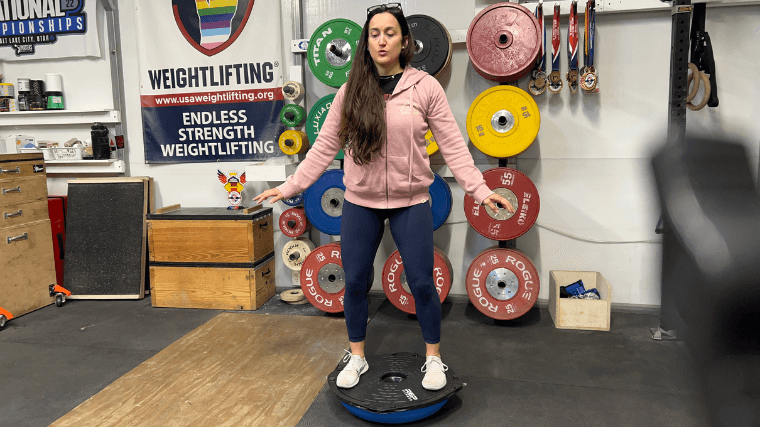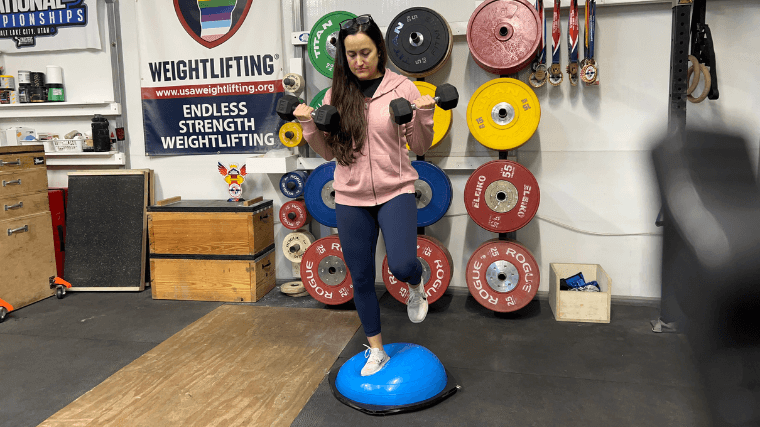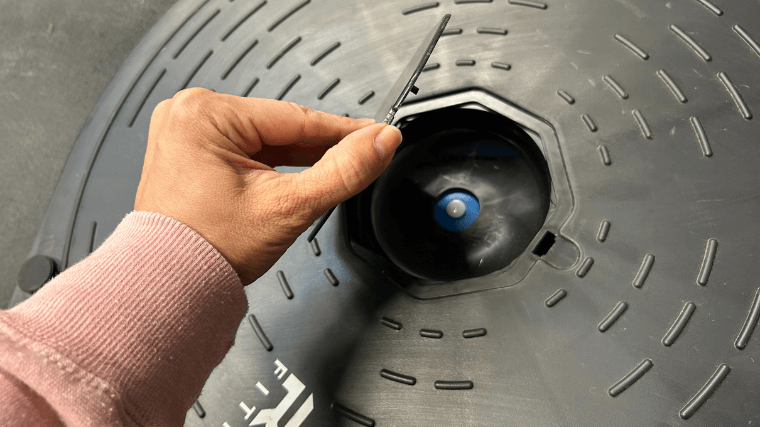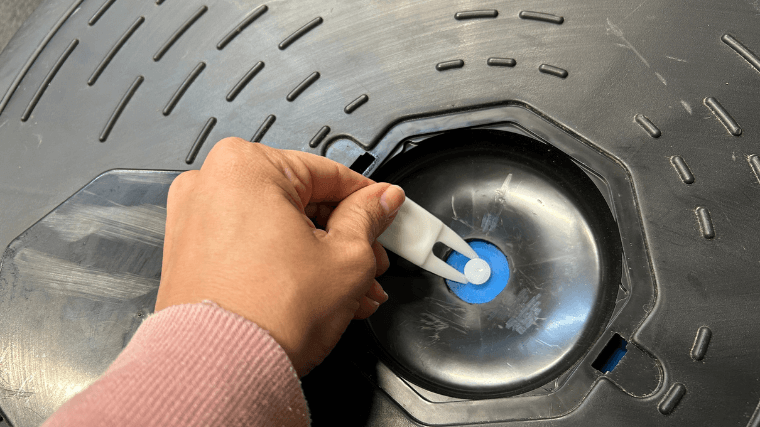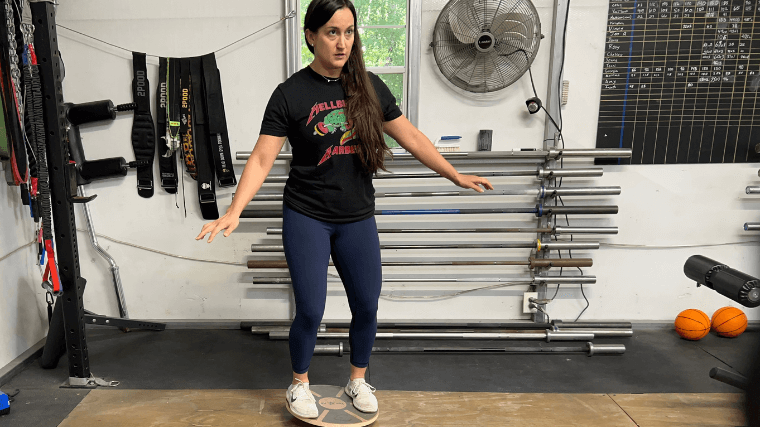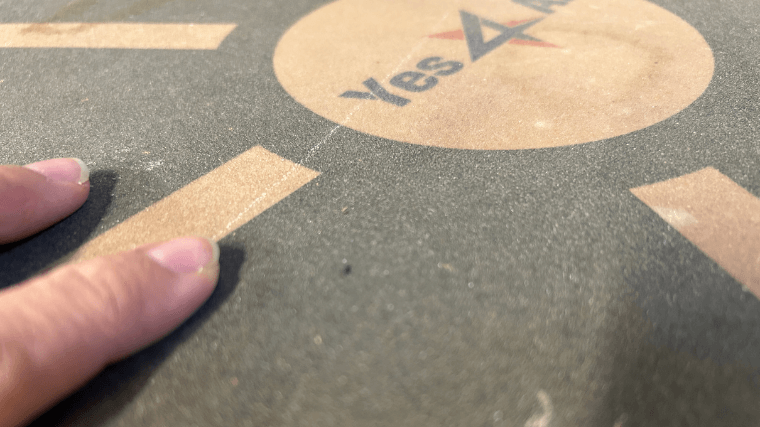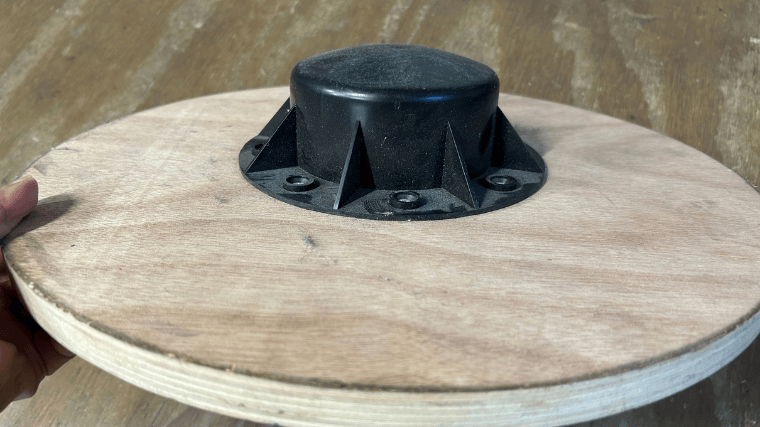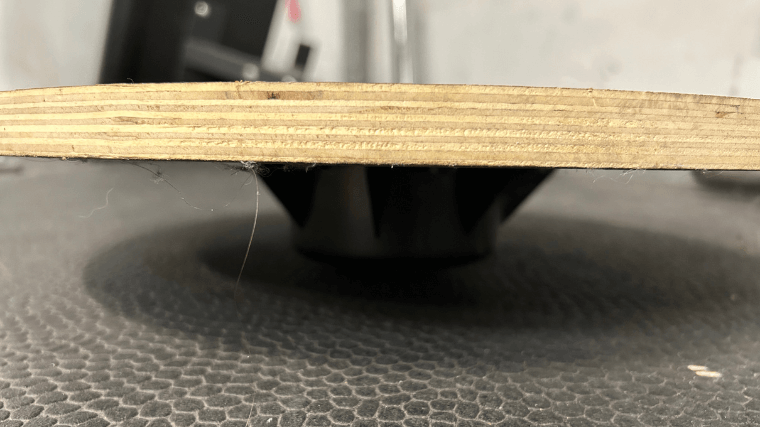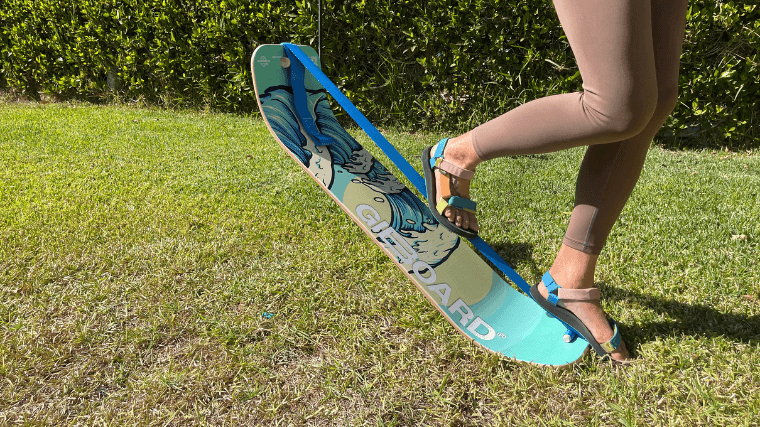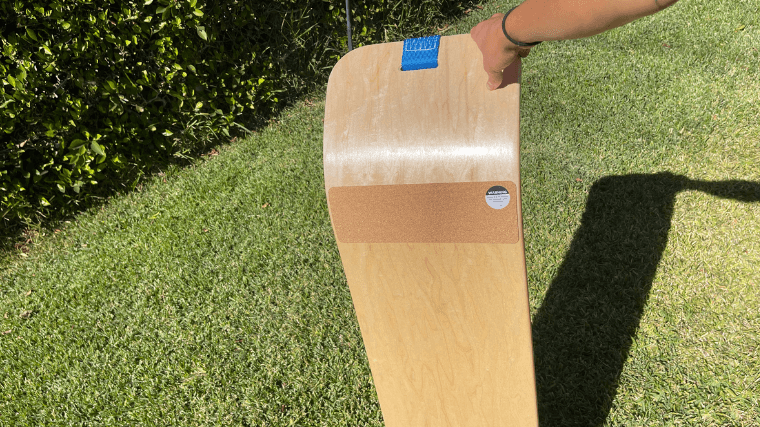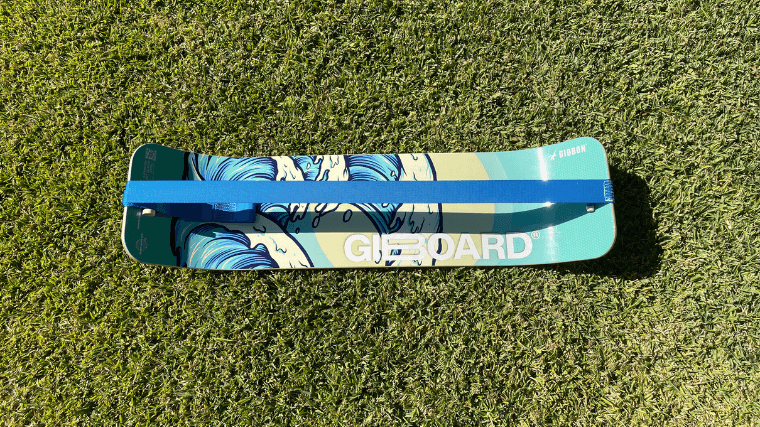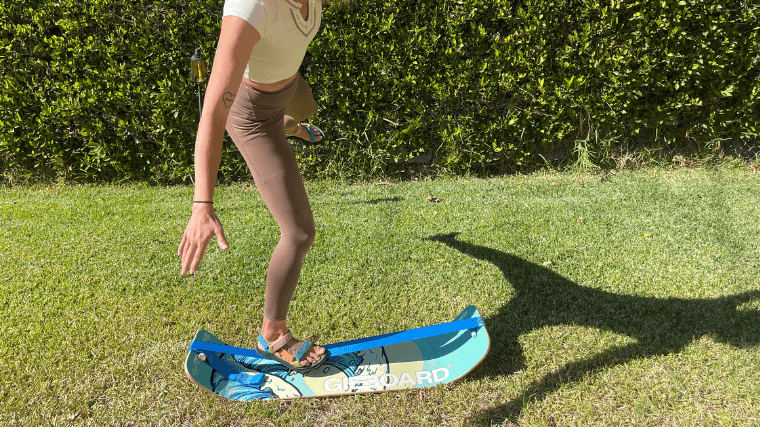You’ve furnished your apartment with the best home gym essentials — some dumbbells or resistance bands for upper-body days and a squat rack to help target your gams, but are you making sure your flexibility and stability keep up with your strength? The best balance boards are versatile pieces of equipment, allowing users to reap the benefits of balance training with prehab and rehab exercises, focused sport-specific workouts, and even low-impact activity at a standing desk during the workday.
We got our hands on some of the best balance boards on the market, utilizing three testers: a certified personal trainer, a CrossFit Level 1 coach, and me, a former collegiate volleyball player, to see what’s what when it comes to balance trainers. The following are our favorites for bringing balance exercise into your home, whether you’re watching TV, nodding along on Zoom calls, or getting your body right for winter snowboarding or summer surfing.
The 8 Best Balance Boards of 2025
- Best Balance Board Overall: Revolution Balance 101 v2
- Best Balance Board for Beginners: REP Fitness Balance Ball Trainer
- Best Balance Board for Training: Bosu Pro Balance Trainer
- Best Standing Desk Balance Board: Whirly Board
- Best Budget Balance Board: Yes4All Wooden Wobble Balance Board
- Best Advanced Balance Board: URBNFit Wooden Balance Board
- Best Balance Board for Athletes: Indo Board Original
- Best Balance Board for Workouts: GiBoard
Best Balance Board Overall: Revolution Balance 101 v2
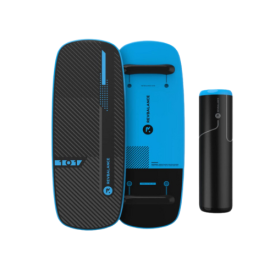
This USA-made roller board is suitable for all levels, thanks to its stopper pads on the bottom that can be adjusted to lessen the amount of roll allowed during your training.
Specs
- Price: $159.95
- Weight: 6.8lbs
- Material: Plastic
- User Weight Capacity: 400lbs
- Footprint: 6” H x 30” L x 13” W
The Revbalance 101 v2, our choice for the best balance board overall, stands out amongst the competition thanks to its comfortable topping and adjustable stoppers. While these types of balance boards slide from side to side, these stoppers can help keep the board from shooting off of the roller — plus, you can adjust the stoppers to limit the area you’re balancing on, which may make it easier for beginners working on balance fitness. Adjustability and workout experience score a 5 out of 5.
Most balance boards we’ve tested have weight limits around 300 pounds, so the 400-pound user weight capacity here makes it a solid overall choice for a range of body types. However, we were forced to dock our score for durability a point, down to a 4 out of 5, because of some customer review complaints.“I don’t like that you need to use glue to fix the item,” mentions a review who had issues with the quality of their roller.
While these types of balance trainers may not be suitable for those with limited mobility — there is a risk of falling — we appreciate that this product comes with a detailed digital workout guide and instructions on how to use this balance board trainer.
Although it isn’t suitable for use at a standing desk like some other balance boards, one of our testers, a certified personal trainer and skateboarder, recommends it for anyone who’s involved with board sports. “It’s a fun way for me to work on the motor skills required for skating.”
Best Balance Board for Beginners: REP Fitness Balance Ball Trainer
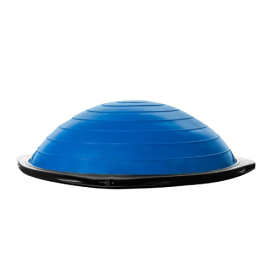
This inflatable balance trainer from REP Fitness allows for stability and balance training through seated, standing, kneeling, and prone and supine positions.
Specs
- Price: $59.99
- Weight: 12lbs
- Material: Plastic and rubber
- User Weight Capacity: 400lbs
- Footprint: 4” H x 24” L x 24” W
The REP Fitness Balance Ball Trainer is our choice for the best balance board for beginners thanks to its affordable $59.99 price tag — less than half the cost of the popular Bosu Ball — and its attachment points for resistance bands, which can assist with stability for those just getting into balance training.
Kate Meier, BarBend editorial member and certified personal trainer, uses this balance ball trainer with her clients. “Whether I’m training someone in their 70s whose focus is on improving stability, or a client who wants to increase balance and coordination to support their bigger lifts, I appreciate that this can be utilized by users of all levels,” she says. Whether it’s used as an exercise for older adults or as part of a warm-up before your working sets, ease of use scores a 5 out of 5.
As mentioned, this is a budget-friendly Bosu-ball-esque trainer, and understandably, Meier doesn’t think it’s as durable as its competitor. “This trainer isn’t going to last me forever, but it’s an affordable option so I don’t mind this issue of durability,” she says, scoring durability a 3.5 out of 5.
Additionally, there are a few other elements we think are missing. “The flat surface side has slightly less grip surface than other balance ball trainers I have used,” mentions a customer review.
Similarly, the ball’s height is 4 inches with a 24-inch diameter. That’s 6 inches shorter and 1.6 inches smaller than another product we’ve tested, the Bosu Ball. “It’s about an inch or two smaller than [other] balance trainers…It makes a difference for bigger guys with a wider stance,” mentions another customer review.
Due to this smaller size, which may not be ideal for every body type, workout experience scores a 4 out of 5. However, for more than half the price of the Bosu Ball, it still provides a high level of training capabilities, and as such, value scores a 5 out of 5.
Best Balance Board for Training: Bosu Pro Balance Trainer
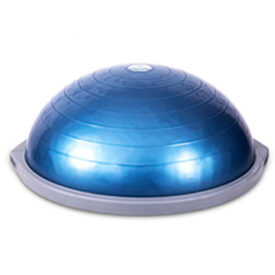
The BOSU Pro Balance Trainer is a 65 cm half-round ball with a non-slip, dually over-molded base. It weighs 19 pounds on its own, so adding it to any movement can help you get stronger.
Specs
- Price: $174.99
- Weight: 19lbs
- Material: Latex-free, burst-resistant material
- User Weight Capacity: 350lbs
- Footprint: 25” H x 25.6” D
The Bosu Pro Balance Trainer, one of the best exercise balls we’ve tried and tested, is a staple in commercial gym settings and rehab offices because of its unmatched ability to aid in a variety of training. (Bosu Balls are so popular, they’re like Google and Tupperware – where the brand name has become synonymous with the type of product it provides.) Kneel on it. Stand on it. Lie on it. Do crunches on it. Flip it over and hold a plank on it. There are countless ways users can add balance and coordination training to their gym sessions.
Our tester, a certified personal trainer, likes to use her Bosu Ball while doing crunches and burpees with an added focus on stability. “I start in a plank, holding onto the side handles, then jump up onto my feet and lift the Bosu overhead,” she says, scoring workout experience a 5 out of 5.
With a 25.6-inch diameter and a height of 10 inches (when fully inflated), it provides a large amount of space for users of varying body types or athletes wanting the ability to stand comfortably atop their balance trainer.
Since Bosu Balls are inflated, there’s always the chance that a cat claw or random sharp edge could spell trouble. Even some customer reviews mention their disappointment with this. “I love this piece of equipment, but I don’t love having to inflate it constantly,” mentions a reviewer who struggles with keeping their Bosu fully inflated. However, Bosu states that this product “lasts 10 times longer than the competition.” If you encounter any issues, the 1-year limited warranty can help resolve any issues.
While the side handles do allow you an advantage when it comes to training or moving this balance ball around, we aren’t impressed with the ability to easily stow this away. Due to its dome and round shape, when not in use it doesn’t stack with other equipment or fit seamlessly into corners. Storage capabilities score a 3 out of 5.
Best Standing Desk Balance Board: Whirly Board
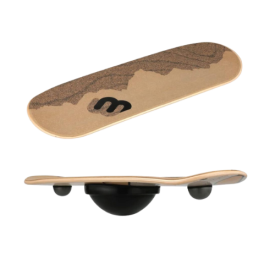
Utilizing a wider version of a skateboard deck, this balance board can be used at standing desks to help relieve work strain while strengthening your core. This board can tilt forward, backward, and side-to-side, plus is capable fo spinning 360 degrees.
Specs
- Price: Starting at $149.95
- Weight: 5lbs
- Material: Wood
- User Weight Capacity: 500lbs
- Footprint: 5” H x 32” L x 8” W
For those of us who struggle to sit still — I’ve gotten up eight times while trying to write this sentence — the world has evolved in our favor. From the best under-desk treadmills and standing desks, our need to move has become something we can easily support even when stuck at our desks. We’ve crowned the Whirly Board as the best standing desk balance board, thanks to its ability to help practice your balance while you work.
The Whirly Board is made from a skateboard deck, with a polyethylene balance ball in the center. What’s unique about this balance board is the versatility of movement it allows. “Other standing desk boards keep you fixed in one spot while the Whirly allows you to move around… You can rotate side to side, or even walk it around by using the outer end balls all while staying on the board. Plus you can always take a quick break from work and try some spins or tricks,” says a customer review.
For those unaccustomed to balance training while working, it may take some patience before you’re comfortable using this tool during your workday. “You see progress in your balance fast enough that you can still type and have online meetings without distraction. But not so fast you get bored of it and shove it to the side because the novelty wore off,” mentions a customer review. For this, we give ease of use a 4 out of 5.
It’s compact and portable so you can carry it from your home office into your office office to keep the balance gains coming. Portability scores a 5 out of 5. However, the brand doesn’t recommend using this on wooden or slippery floors, so you’ll want to use a workout mat or something similar to keep the board from slipping.
Perusing customer reviews, this product is well-liked by those preparing for snowboard sessions and anyone looking for some balance training from their standing desk. While the cost of the board, which ranges from $149.95 up to $179.95 for a wider option that some may prefer to use at their standing desks, is relatively high, customer reviews still praise its value and versatility.
Best Budget Balance Board: Yes4All Wooden Wobble Balance Board
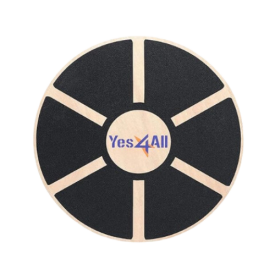
This wooden balance board is one of the most affordable options on the market, with prices starting at $15.99. It can hold users up to 300 pounds and be utilized by standing on it or doing planks or pushups with it.
Specs
- Price: Starting at $15.99
- Weight: 3.1lbs
- Material: Wood
- User Weight Capacity: 300lbs
- Footprint: 3” H x 15.75” L x 15.75” W
When you’re busy saving for a rainy day, you can still bring home the best budget home gym equipment to support your training (and bank account). The Yes4All Wooden Wobble is our choice of the best budget balance board due to its itty-bitty $15.99 price tag. That’s about the same cost as a Chipotle burrito these days. Kate Meier, Barbend editorial member and certified personal trainer, and I both have used this balance traine,r and while it’s not the fanciest piece of equipment, it gets the job done. Value scores a 5 out of 5.
Unlike other balance trainers we’ve tested, the Yes4All Wooden Wobble takes up a measly 1.7 square feet of floor space and weighs only 3 pounds, so it’s easy to move around (or shove under the couch when not in use).
It’s made from wood with grip tape to keep your feet from slipping. While Meier appreciated this anti-slip surface, I didn’t like it because it made doing planks and pushups uncomfortable on my forearms and hands. Similarly, because the diameter of this trainer is only 15.75 inches, I felt limited in what I could do on it while standing. Ergonomics score a 3 out of 5. Meiers agrees, “The narrow build may prove challenging for those unaccustomed to balance training.”
This balance trainer rests on a base that supports up to 300 pounds and allows for 15 degrees of wobble, which may feel limiting for more experienced users. Additionally, it’s worth noting that a common complaint in online reviews (although few and far between) is that the base can slip. “It works well on carpet, but it slides on tile/hardwood,” mentions a customer review who suggests using a yoga mat if needed.
Best Advanced Balance Board: URBNFit Wooden Balance Board
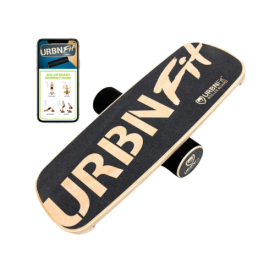
This roller board helps with balance, stability, and core strength as users try to maintain their balance while riding a wooden board on a cylindrical tube. While this model does feature lips on the edges to help keep the board from falling off, these types of balance trainers are best suited for individuals without mobility limitations.
Specs
- Price: $73.99
- Weight: 9lbs
- Material: Wood
- User Weight Capacity: 300lbs
- Footprint: 6” H x 29.25” L x 11.5” W
Roller boards can help take your mobility, flexibility, and balance skills to new heights, but they can also send you flying off backward with your legs in the air. With that in mind, we’ve chosen the URBNFit Wooden Balance Board as the best advanced balance board. This training system utilizes a long wooden board that you must keep balanced on top of a cylindrical roller — a beloved style of balance training for surfers, snowboarders, and skaters in the off-season.
Our tester tried the URBNFit Balance Board and was blown away at how difficult it was to use. “I nearly flew off a few times, but once I got the hang of it, it challenged every muscle in my body — especially my core,” she says. While we’ve tested similar types of boards, the difficulty here comes from the amount of board that the roller can cover. While there are lips at the end of the board to keep the wood from flying off, we wish that there were options to include stoppers on the board, limiting the roll area and making it more accessible to a wider range of skill levels. Ease of use scores a 3 out of 5.
This is a board that’ll take some trial and error before you really get the hang of it. “Honestly, I didn’t expect this to be so much work to try to learn, so I am happy I started doing this as it has improved my balance and equilibrium, plus increased my ankle and core strength,” says a customer review. What’s more, you’ll also receive a workout guide that can help you navigate the ways in which you can up the ante on your home workouts. Workout experience scores a 5 out of 5.
While our tester didn’t experience any issues with durability, it’s worth noting that some users online have complained about the board snapping or the non-slip surface peeling. “It broke when I got on it [and] I weigh 180 pounds,” mentions a customer review who was disappointed by the promised 300-pound user weight capacity. Durability scores a 3.5 out of 5.
Best Balance Board for Athletes: Indo Board Original
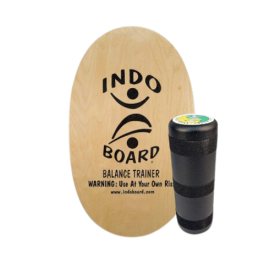
This roller board's simple design is often utilized by surfers, snowboarders, and skateboarders, to help build up balance and flexibility. The wooden board is made from a durable Birch wood that's covered in a non-slip surface so you can train with or without shoes on.
Specs
- Price: Starting at $226.95
- Weight: Not listed
- Material: Baltic Birch plywood
- User Weight Capacity: 350lbs
- Footprint: 18” W x 30” L
Maybe this was an isolated incident, or maybe it’s because I went to a hippie-surfer-stoner college, but the Indo Board was a staple in nearly every dorm room in the 2010s. The Indo Board Original, our choice of the best balance board for athletes, consists of an oval wooden deck that rides over a cylindrical roller, creating a continuously unstable surface. It’s often used by athletes in sports like surfing, skateboarding, and snowboarding because it forces you to develop core stability and learn how to react to changes quickly.
While this type of balance training is often best utilized by experienced athletes or those without mobility limitations, we love that the Indo Board gives you the option to select a package with a roller and cushion.
The roller has a steep learning curve and if you’re anything like me, you will go flying off of it in the middle of a house party — a reason why we gave ease of use a 3 out of 5. However, there’s an option to purchase a cushion which allows athletes to build up a base level of balance — similar to weightlifting progress that takes time and repeated effort — before proceeding to using the roller. This Indoflo cushion is inflatable and adjustable so you can choose to increase or decrease the difficulty of your workout. Workout experience scores a 5 out of 5.
The board is made from 11/16-inch Cabinet-grade Baltic Birch plywood and is coated in a non-slip surface that can be used with shoes or bare feet. If you’re unaware of your woods, Baltic Birch plywood is praised for its durability and stability when compared to standard birch plywood. (1) For the Indo’s choice of quality material, durability scores a perfect 5 out of 5.
While the Indo is a solid choice for athletes, the price is one of the highest we’ve seen for balance trainers. We’d recommend making sure you’d truly dedicate time and effort into mastering this equipment because if it just ends up collecting dust, the high-end price isn’t worth it.
Best Balance Board for Workouts: GiBoard
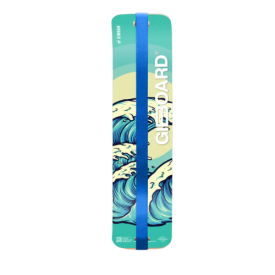
This portable, mini slackline trainer can help you build stability and core strength as you find your balance on the 2-inch wide webbing. The portable board is a light 7.5 pounds and it can support users up to 400 pounds.
Specs
- Price: Starting at $199.99
- Weight: 7.5lbs
- Material: Trick line webbing, wood
- User Weight Capacity: 400lbs
- Footprint: 5.5” H x 42” L x 11” W
Our choice for the best balance board for workouts is the GiBoard — a unique type of balance board that utilizes a 42-inch slackline that’s strung up against a curved wooden board. The workout has been surprisingly satisfying, with sweat on my brow after a few minutes of use, and noticeable improvements from one day to the next. Workout experience and durability earn a perfect 5 out of 5.
My first day testing the GiBoard was humbling — I couldn’t even stand on the slackline for more than a second without stepping off. But each day I came back, I got a little bit better. Day two, I could balance for a few seconds. Day three, I could take one step. By day five, I was able to walk forward and back, even tipping the end of the board like an instructional trick video online showed me. Additionally, I’ve done planks and core work by balancing either my hands or butt on the slackline. Workout experience scores a 5 out of 5.
Attempting to stay on this portable slackline requires my core to engage and all these little muscles in my feet, ankles, calves, thighs, and glutes (fine, maybe every muscle) to fight to maintain balance. You’ll want some space on either side of the board for moments when your balance isn’t balancing, so using this while working from a standing desk doesn’t seem ideal, possible, or recommended. Functionality scores a 4 out of 5.
It’s lightweight at only 7.5 pounds and I can easily cart it from the living room to the backyard when I need a change of scenery. However, it’s awkwardly shaped, so the options for storage are a bit more limited than a typical balance board.
While I only spend about a minute or two on it each time I step on, the GiBoard reminded me how quickly progress can happen when you’re willing to dedicate some time each day, one wobbly step at a time.
How We Tested and Chose the Best Balance Boards
The team here at BarBend is made up of certified personal trainers, and strength and sports athletes. We’ve gotten our feet on several of the best balance boards on the market, providing our honest feedback to help you navigate your options. By utilizing the BarBend equipment testing methodology, we’ve provided scores from 1 (bad) to 5 (great) in areas like durability, workout experience, value, and more. Below are some key areas we dialed in on.
- Type of Balance Board: We’ve included roller boards, rocker boards, wobble boards, and slackline boards within this list. Each type of board provides a different range of movement and we wanted to give a sampling of each.
- Learning Curve: The balance boards on our list each provide different levels of difficulty. We wanted to include options that were easy to step onto and some that required practice to master to suit every type of balance trainee.
- Grip Surface: In testing, we made sure we could stay atop the balance boards we wanted to recommend. If we went flying, or the board’s grip was uncomfortable, we made sure to mention it.
- Balance Training: The goal with balance boards is to “challenge balance, coordination, and stability,” says BarBend expert contributor and certified personal trainer Amanda Capritto. However, since each user has differing capabilities, we made sure to choose items that could suit various individuals.
Benefits of Balance Boards
Similar to the benefits of stability balls, balance boards offer a wealth of rewards for users who build this type of training into their routine. If you’re still not on board — hopefully it isn’t because you’ve slipped off a roller board — the following are some of the benefits of balance boards and what these reasonably small tools can do for you, your body, and your fitness goals.
- Reduced Risk of Injury: The act of completing balance board training may cause you to fall if you’re not careful. However, improving your balance and stability with these training tools can help limit injuries such as ankle sprains and reduce falls, especially in older populations. (2)(3)
- Mental Benefits: Taking some time out of your day to work on your balance is actually mentally stimulating. In fact, studies have shown that balance training can improve focus and cognitive function in healthy adults. (4)
- Improved Sport Performance: The Strength Level of the NASM Optimum Performance Training model has a deep focus on balance training. This is because increased balance improves sport-beneficial proprioception and neuromuscular function in addition to reducing sports-related injuries. (5)
- Portable: Similar to the best resistance bands, balance boards tend to be relatively small, lightweight, and portable, making them ideal for those in small spaces or wanting to take their training on the go.
- Helps You Stay Active: Balance training can help you stay active during sedentary tasks. “A sedentary lifestyle can lead to serious health problems, like heart disease, diabetes, obesity, and high blood pressure. It can also harm your mental health, increasing the chances of anxiety and depression,” says BarBend expert contributor, Dr. Raj Dasgupta. (6)
How Much Do Balance Boards Cost?
We’ve assembled a lineup of balance boards that can suit budgets big and small. Our top choices range in cost from $15.99 up to $226.95.
| Best Balance Board Overall | Revolution Balance 101 v2 | $159.95 |
| Best Balance Board for Beginners | REP Fitness Balance Ball Trainer | $59.99 |
| Best Balance Board for Training | Bosu Pro Balance Trainer | $174.99 |
| Best Standing Desk Balance Board | Whirly Board | $149.95 |
| Best Budget Balance Board | Yes4All Wooden Wobble Balance Board | Starting at $15.99 |
| Best Advanced Balance Board | URBNFit Wooden Balance Board | $73.99 |
| Best Balance Board for Athletes | Indo Board Original | Starting at $226.95 |
| Best Balance Board for Workouts | GiBoard | Starting at $199.99 |
What to Consider Before Buying Balance Boards
Whether you’ve been balancing since the day you were born, crushing inversions in yoga class while everyone else does frog pose, or you’re new to this type of training, there are a variety of considerations you’ll want to make before you rashly pick one to bring home. The following are key areas to mull over before making a selection
Type of Balance Board
There are a variety of balance boards worth your consideration, and each option offers a different type of training modality.
- Wobble boards offer 360 degrees of freedom to tilt forwards, backward, and side to side.
- Rocker boards only move in two directions, either forward and back or side to side.
- Inflatable boards remain fixed in one spot, but the air within these half domes can force you to continuously work to regain balance.
- Roller boards balance on a tube and allow side-to-side movement.
- Slackline boards feature a short webbing slackline that users can practice balancing on.
Skill Level
Consider your current balance capabilities and what it is you’re looking to gain from balance training. Beginner-friendly options are wobble boards, inflatable boards, and rocker boards, and they can help increase balance abilities without adding too much risk of the user falling.
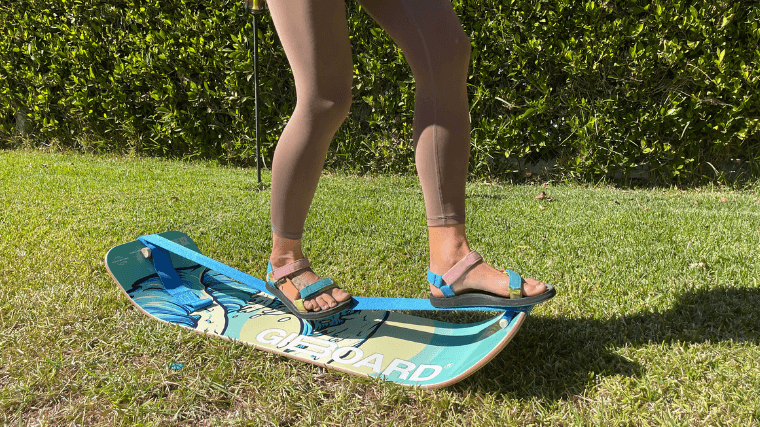
Roller boards and slackline boards are best suited for more experienced riders because both options place the user in a more unstable position. Additionally, these options, once the basics have been mastered, provide users with the ability to learn tricks.
Balance While Working
If you’re interested in choosing a balance board that you can use to up your stability gains while working from a standing desk, you’ll want to consider the stability, profile, and amount of control offered by the board. Boards with rollers and slacklines may be too difficult to use while typing, and the heightened risk of a fall turns your desk into a safety hazard.
To best be able to get an office workout in from a standing desk while balancing, consider a balance board with a low profile and a fixed platform, or a board with an inflatable surface. Rocker boards, wobble boards, and inflatable boards each are worthwhile considerations when looking to add some balance work to your work work.
Balance Boards FAQs
What’s better, a balance board or a wobble board?
Wobble boards fit into the larger balance board family, but they’re often best suited for use at standing desks or for rehab or prehab exercises. Wobble boards also tend to be lower to the ground, so they’re ideal for beginners or users who struggle with stability.
What is the best balance board?
In our humble opinion, the Revolution Balance 101 v2 is the cream of the crop. This balance trainer is a roller board, but it features stoppers on the underside of the board, which can be adjusted to suit beginners, intermediate, and advanced-level athletes.
Is balance training good for the knees?
Should seniors use a balance board?
Maybe yes, maybe no. Balance training has been shown to improve stability and reduce the risk of falls in adults over the age of 65, and balance boards can assist with that training. (9) When incorporating a balance board into a set of balance exercises for seniors, be sure to choose one appropriate to an older adult’s skill and ability.
References
- Legros, S. (2024, April 23). Birch Plywood vs. Baltic Birch – Forest Plywood. https://forestplywood.com/blog/plywood/birch-plywood-vs-baltic-birch/#:~:text=Standard%20birch%20plywood%20is%20more,birch%20has%20very%20few%20voids.
- Al Attar, W. S. A., Khaledi, E. H., Bakhsh, J. M., Faude, O., Ghulam, H., & Sanders, R. H. (2022). Injury prevention programs that include balance training exercises reduce ankle injury rates among soccer players: a systematic review. Journal of physiotherapy, 68(3), 165–173. https://doi.org/10.1016/j.jphys.2022.05.019
- McLaughlin, E. C., El-Kotob, R., Chaput, J. P., Janssen, I., Kho, M. E., Poitras, V. J., Ross, R., Ross-White, A., Saunders, T. J., Sherrington, C., & Giangregorio, L. M. (2020). Balance and functional training and health in adults: an overview of systematic reviews. Applied physiology, nutrition, and metabolism = Physiologie appliquee, nutrition et metabolisme, 45(10 (Suppl. 2)), S180–S196. https://doi.org/10.1139/apnm-2020-0279
- Rogge AK, Röder B, Zech A, Nagel V, Hollander K, Braumann KM, Hötting K. Balance training improves memory and spatial cognition in healthy adults. Sci Rep. 2017 Jul 18;7(1):5661. doi: 10.1038/s41598-017-06071-9. Erratum in: Sci Rep. 2018 Nov 22;8(1):17434. doi: 10.1038/s41598-018-35957-5. PMID: 28720898; PMCID: PMC5515881.
- Stull, K. (n.d.). Supersets for legs and back – Exercises to burn calories. https://blog.nasm.org/supersets-lift-weight-to-lose-weight
- Gao Z, Lee JE. Promoting Physical Activity and Reducing Sedentary Behavior to Prevent Chronic Diseases during the COVID Pandemic and Beyond. J Clin Med. 2022 Aug 10;11(16):4666. doi: 10.3390/jcm11164666. PMID: 36012905; PMCID: PMC9410464.
- Prabhakar, A. J., R, S., Thomas, D. T., Nayak, P., Joshua, A. M., Prabhu, S., & Kamat, Y. D. (2023). Effectiveness of balance training on pain and functional outcomes in knee osteoarthritis: A systematic review and meta-analysis. F1000Research, 11, 598. https://doi.org/10.12688/f1000research.111998.2
- Pirayeh N, Kazemi K, Rahimi F, Mostafaee N, Shaterzadeh-Yazdi MJ. The Effect of Balance Training on Functional Outcomes in Patients with Knee Osteoarthritis: A Systematic Review. Med J Islam Repub Iran. 2022 Sep 17;36:107. doi: 10.47176/mjiri.36.107. PMID: 36447558; PMCID: PMC9700426.
- Halvarsson A, Dohrn IM, Ståhle A. Taking balance training for older adults one step further: the rationale for and a description of a proven balance training programme. Clin Rehabil. 2015 May;29(5):417-25. doi: 10.1177/0269215514546770. Epub 2014 Sep 8. PMID: 25200877; PMCID: PMC4419050.
